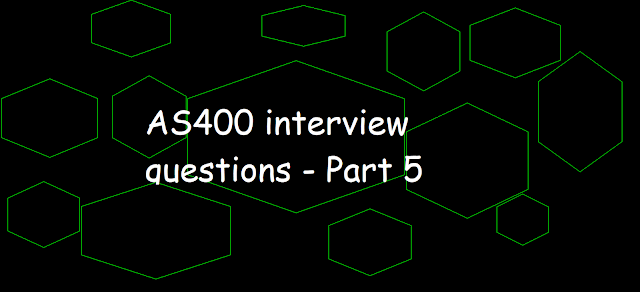 |
| AS400 Interview questions - Part 5 |
Q1: What are SFL and SFLCTL?
Answer:
- Subfile format (SFL) is used to define the Subfile record format.
- Subfile control format (SFLCTL) is used to define the Subfile control record format.
Q2: List some of the commonly used commands for debugging?
Answer:
- STRDBG
- STRISDB
Q3: What are SFLCSRRRN and SFLRCDNBR?
Answer:
- Subfile cursor relative record number (SFLCSRRRN) is used to return the RRN of the record on which the cursor is located within the Subfile.
- A subfile record number (SFLRCDNBR) is used to specify the Subfile page to be displayed that contains the RRN of the record in this field. It is defined inside the Subfile control format.
Q4: How to print header if O specs are used in the program?
Answer:
- EXCEPT
Q5: How to define global variables in RPG?
Answer:
- Using EXPORT keyword.
Q6: What is a service program?
Answer:
- A service program is a set of RUNNABLE procedures.
Q7: What is the *ISO date format?
Answer:
- YYYY-MM-DD
Q8: How can we copy messages from one message file to another?
Answer:
- MRGMSGF
Q9: What is the significance of the QTEMP library?
Answer:
- QTEMP is a temporary library and associated with each session.
- So every session has its own QTEMP.
- We cannot access any other session QTEMP library.
- Whatever we have in QTEMP cannot be accessed by Batch Jobs.
- Submitted batch jobs have their own QTEMP.
- It gets created once the user sign-on.
Q10: If no current library exists in which library does the create command creates the object?
Answer:
- QGPL
Q11: Is the library list an object? In which order it is searched?
Answer:
- No, it's not an object
- First System, then product, and then User libraries will get searched for the object.
Q12: What is the difference between production and Test libraries?
Answer:
- Production libraries - In debug mode, you can protect database files from being updated.
- Test libraries - In debug mode, you cannot protect database files from getting updated.
Q13: What is the significance of the values *LIBL, *ALLUSR, and *USRLIBL for the library parameter on any command?
Answer:
- *LIBL - search for objects in the libraries added to the library list of that session.
- *ALLUSR - search for objects in all the user libraries present on the system.
- *USRLIBL - search for objects in all the user libraries present on the library list and ignore the system libraries.
Q14: What is a flat-file?
Answer:
- File with no DDS source and having record length.
- File name, a record format name, and field name are the same in a flat-file.
Q15: If a CL program contains a reference to a flat file, how can the data be retrieved in the CL program?
Answer:
- retrieve &FILENAME (field name is same as the file name)
Q16: How many record formats can a database file have, which is declared in CL?
Answer:
- 1
Q17: Do I need to declare the file fields, which are declared in CL?
Answer:
- No
Q18: What happens if a file is created with an expiry date less than the current date?
Answer:
- The file gets created with no member and throws an error for expiry date invalid.
Q19: Under what circumstances we will not be able to delete a PF?
Answer:
- If it has dependent.
- It's in use by some process.
- Authority issue.
Related Post
AS400 Interview Questions - Part 1
AS400 Interview Questions - Part 2
AS400 Interview Questions - Part 3
AS400 Interview Questions - Part 4
AS400 Interview Questions - Part 6
AS400 Interview Questions - Part 7
AS400 Interview Questions - Part 8
AS400 Interview Questions - Part 9
AS400 Interview Questions - Part 10
AS400 Interview Questions - Part 11
AS400 Interview Questions - Part 12
As400 Interview Questions - Part 13
AS400 Interview Questions (DB2) - Part 1
AS400 Interview Questions (DB2) - Part 2